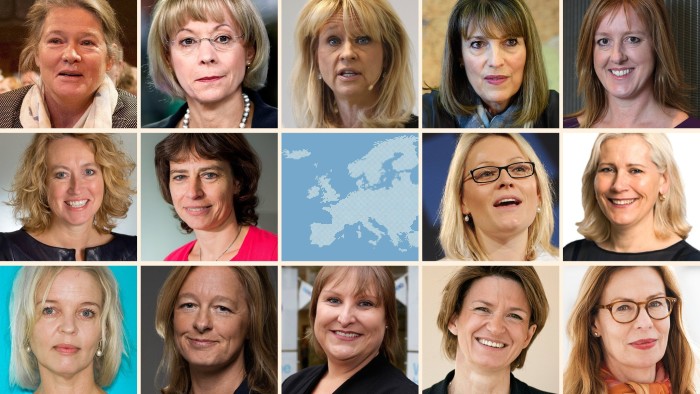Perilous times lie in wait for women who take the helm

Roula Khalaf, Editor of the FT, selects her favourite stories in this weekly newsletter.
The men have fled, there is a power vacuum at the top and a woman has taken over in a time of crisis. Is she being set up to fail?
If evidence were needed to support the theory that women only get the top job in particularly precarious times, Theresa May, the new UK prime minister, is that woman, says Michelle Ryan. Prof Ryan is an academic at Exeter University who, along with Alex Haslam, first coined the phrase “glass cliff” to describe the trend in 2005.
Although the 59-year-old head of the UK’s Conservative party has harboured leadership ambitions for several years, “it is interesting that this is the time she gets it,” Ms Ryan adds.
“She will be in the position of not being able to please anyone.” No matter what she does on the European Union question, “50 per cent of the population are going to be happy and the other 50 per cent unhappy.”
The argument is that women are set up to fail — pushed into leadership positions to take the flak or when a scapegoat is needed.
In other cases, it is because change is required, and women are more likely to suggest a clean slate than another white man in a grey suit, says Ms Ryan.
Special Report

Pay fairly or watch top performers join your rivals
Many companies are struggling to retain mid-career women
‘Brutal advice’ has its reward
Leyla Boulton catches up with a finance professional and a chairman who were paired in a UK scheme
Online course helps women find sponsors
Aim is to help overlooked staff find senior advocates to diversify top ranks
Diversity needs skilled leaders
Mixed groups with conflicting views require more active and sensitive managers to run them
Close the gender gap to boost output
Narrowing the gender divide offers economic gains as well as societal benefits
Essay winner: Diversity benefits companies
Despite slow progress, women will exert their influence over the coming decade, writes Ivana Vasic Chalmers
Soon after Iceland’s three main banks failed in October 2008, Jóhanna Sigurdardóttir was installed as the nation’s first female prime minister and women were appointed to run two of the nationalised banks.
Marissa Mayer, chief executive of Yahoo, which last week revealed it had suffered the biggest-known data breach to date, was initially hailed as a trailblazer who could rescue the technology and media company. Soon after her arrival she was castigated for everything from her decision to clamp down on staff working at home to her choice of taking only a short maternity leave.
Mary Barra’s promotion to chief executive of General Motors in 2014 was welcomed as a victory for gender equality because she was the first woman to head a global carmaker. Two months after she was appointed, GM announced that it had to recall 2.6m cars because of faulty ignition switches implicated in the deaths of at least 13 people.
This raised questions about whether Ms Barra or other executives knew a crisis was unfolding when she was appointed — putting her on, as it were, the very precipice of the glass cliff.
There is a host of examples of women taking leadership positions during crises but Per-Ola Karlsson, a consultant at Strategy&, part of PwC, says the glass cliff theory “may be a myth and that other factors can explain what we see”.
Women accounted for just 10 of the incoming 359 chief executives worldwide in 2015, the lowest rate since 2011, according to Strategy&’s annual study of 2,500 companies.
In North America, just one female chief executive was appointed during the entire year: Andrea Greenberg at sports and entertainment company MSG Networks.
But while it is clear that “many factors including leadership development approaches and cultures make it that much harder for women”, Strategy& has not found any statistical evidence to back the idea that female leaders were brought in more often during crises, says Mr Karlsson.
What it did find was that in the previous decade female chief executives were 27 per cent more likely to be forced out than male chief executives.
Harriet Green, referred to by the Daily Mail tabloid as the “Gucci-loving blonde with a tattoo — and a temper”, joined the travel agent Thomas Cook as chief executive in 2012 when there were fears for the company’s survival.
Even though she transformed the company’s fortunes, Ms Green was forced out by the board two years later.
Strategy&’s research suggests one reason women are forced out is that they are more likely than men to be hired from outside the company, and outsiders, irrespective of gender, are more likely to end up being dismissed. Outsiders lack the internal networks and knowledge that help them survive.
Still, the intense scrutiny faced by female bosses may deter women from competing for leadership positions, says Jenny Campbell, chief executive of YourCash Europe, the ATM provider formerly called Hanco ATM systems.
Although Ms Campbell was appointed to lead Hanco when it was in crisis, she believes that this was thanks to her experience at Royal Bank of Scotland, its then owner, rather than anything to do with her gender.
Ms Campbell’s argument is that plenty of men are also appointed to leadership positions during troublesome times but that women — still a rarity at the top — attract more attention when they fail. “Female leaders that haven’t succeeded in business are more visible and more likely to be put under the microscope simply because they are female,” she says.
All to say that even if there are cracks in the glass cliff theory, an extra set of crampons may come in hand for Mrs May and other women who have smashed the glass ceiling and want to stay on the summit.
Comments